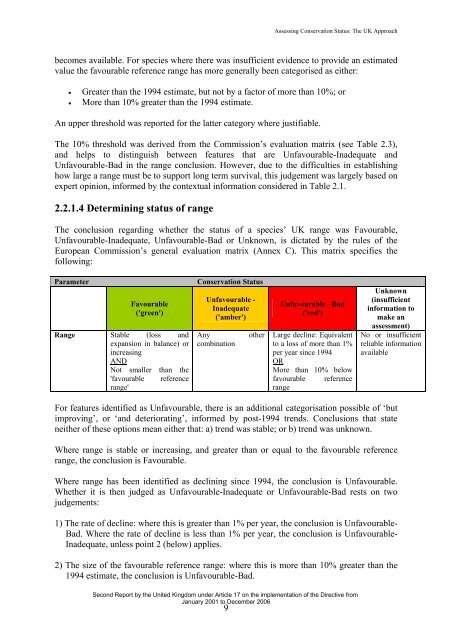Assessing Conservation Status: The UK Approach - JNCC
Assessing Conservation Status: The UK Approach - JNCC
Assessing Conservation Status: The UK Approach - JNCC
Create successful ePaper yourself
Turn your PDF publications into a flip-book with our unique Google optimized e-Paper software.
<strong>Assessing</strong> <strong>Conservation</strong> <strong>Status</strong>: <strong>The</strong> <strong>UK</strong> <strong>Approach</strong><br />
becomes available. For species where there was insufficient evidence to provide an estimated<br />
value the favourable reference range has more generally been categorised as either:<br />
• Greater than the 1994 estimate, but not by a factor of more than 10%; or<br />
• More than 10% greater than the 1994 estimate.<br />
An upper threshold was reported for the latter category where justifiable.<br />
<strong>The</strong> 10% threshold was derived from the Commission’s evaluation matrix (see Table 2.3),<br />
and helps to distinguish between features that are Unfavourable-Inadequate and<br />
Unfavourable-Bad in the range conclusion. However, due to the difficulties in establishing<br />
how large a range must be to support long term survival, this judgement was largely based on<br />
expert opinion, informed by the contextual information considered in Table 2.1.<br />
2.2.1.4 Determining status of range<br />
<strong>The</strong> conclusion regarding whether the status of a species’ <strong>UK</strong> range was Favourable,<br />
Unfavourable-Inadequate, Unfavourable-Bad or Unknown, is dictated by the rules of the<br />
European Commission’s general evaluation matrix (Annex C). This matrix specifies the<br />
following:<br />
Parameter<br />
Favourable<br />
('green')<br />
Range Stable (loss and<br />
expansion in balance) or<br />
increasing<br />
AND<br />
Not smaller than the<br />
'favourable reference<br />
range'<br />
<strong>Conservation</strong> <strong>Status</strong><br />
Unfavourable -<br />
Inadequate<br />
('amber')<br />
Any<br />
combination<br />
other<br />
Unfavourable - Bad<br />
('red')<br />
Large decline: Equivalent<br />
to a loss of more than 1%<br />
per year since 1994<br />
OR<br />
More than 10% below<br />
favourable reference<br />
range<br />
Unknown<br />
(insufficient<br />
information to<br />
make an<br />
assessment)<br />
No or insufficient<br />
reliable information<br />
available<br />
For features identified as Unfavourable, there is an additional categorisation possible of ‘but<br />
improving’, or ‘and deteriorating’, informed by post-1994 trends. Conclusions that state<br />
neither of these options mean either that: a) trend was stable; or b) trend was unknown.<br />
Where range is stable or increasing, and greater than or equal to the favourable reference<br />
range, the conclusion is Favourable.<br />
Where range has been identified as declining since 1994, the conclusion is Unfavourable.<br />
Whether it is then judged as Unfavourable-Inadequate or Unfavourable-Bad rests on two<br />
judgements:<br />
1) <strong>The</strong> rate of decline: where this is greater than 1% per year, the conclusion is Unfavourable-<br />
Bad. Where the rate of decline is less than 1% per year, the conclusion is Unfavourable-<br />
Inadequate, unless point 2 (below) applies.<br />
2) <strong>The</strong> size of the favourable reference range: where this is more than 10% greater than the<br />
1994 estimate, the conclusion is Unfavourable-Bad.<br />
Second Report by the United Kingdom under Article 17 on the implementation of the Directive from<br />
January 2001 to December 2006<br />
9
















